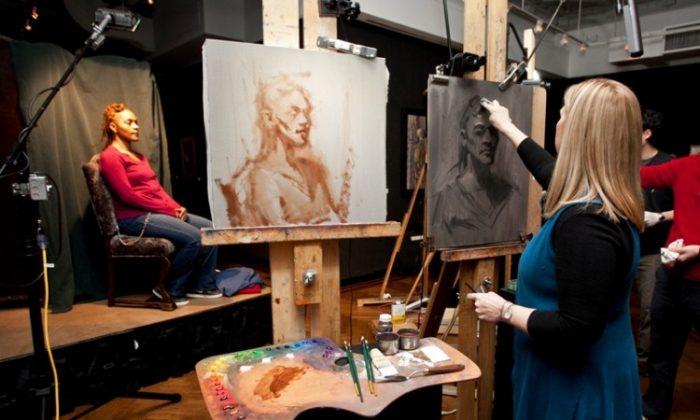Turning the Tide for Arts
Nelson Shanks coined the term “humanist realism” to describe his vision of realist art.
“Humanist realism is primarily art that is conveyed through a sense of realism,” he said. “The objective is to explore humanity through what we see, and what others see through my paintings.”
Shanks contrasts humanist realism with the majority of contemporary art, which he likens to a bubble.
“Modern art has gone off to an area virtually meaningless because of the endless supply of arts of questionable quality and commercial interests. It’s like tulips in Holland in the 17th century—it’s more to do with mania than finding a beautiful tulip.”
New York-based fine artist Manu Saluja, a realist painter of 15 years and a School of Visual Arts graduate who came to see the demonstration, agrees with Shanks, and believes that the market’s pendulum is swinging back toward realism.
“There might be more of an acceptance of contemporary realism now because the modernist views that emerged in the early 1900s, and perhaps even postmodern views, are no longer new and may even be seen as conventional,” she said. “Today I think art critics and collectors understand that to accept only formalism and abstraction as valid forms of painting is passé, and that figurative, representational work is a valid part of the contemporary dialogue.”
Modern art sustains itself because museums, collectors, and dealers essentially collude to drive the demand for modern art, according to Shanks.
“With abstract art, no one knows whether it’s good or bad unless a gallery owner tells you so. But with realism the quality is obvious.”
Yet not all realism is created equal. Shanks says that low-quality realism gives realism a bad name. Some common shortfalls with realism include lack of depth, lack of real visual perception, and subject choice, according to Shanks. Through his teaching, he hopes to arm painters with the highest skills and thereby elevate the level of realist art today.
Nurturing Successful Artists
“In order to be creative as opposed to accidental or erratic, one needs to study,” said Shanks. “The more one studies color, composition, design, and art history, the more skills one has to create. My goal for students, overall, is for them to become instruments in changing the direction of art, not through hollow promotion, but through excellence.”
Part of his mission is to step up where arts education has fallen short.
“Students come out of college with an art degree but realize that they don’t know how to draw or paint,” he said. “Many of the students come to my studio and find it very gratifying, first that such a place exists, and then to actually learn the skills that they were previously denied.”
“In the last 20 or 30 years, there’s been an upward swing in the quality in and interest for realist art,” said Shanks, who has witnessed the steady increase in enrollment at Studio Incamminati. “I’m always proud to see students making big strides, when light bulbs go on as they learn something new and progress.”
The learning doesn’t end with taking classes.
“Students, as they advance, are required to teach,” said Shanks. “By the third or fourth year, teaching is required and becomes an important learning tool. It helps the student to formulate, clarify, and understand what’s been forming in their minds.”
Kelsey, who is in his second year as a teaching fellow, said he’s surprised at the students’ enthusiasm and how much it inspires him. “What’s different about our studio is that we treat the teaching of art a lot like the teaching of music; we do drills of the techniques over and over until they become second nature,” said Kelsey. “It takes hard work and the students who stay understand that.”
Besides teaching at the studio, fellows at the program are often connected to teaching in secondary schools and colleges. Of the artists who have completed the four- to five-year program, almost all are practicing professionals, according to Shanks. The studio also offers occasional lectures about art business.
“We increase the likelihood of an artist being successful,” he said. “I would say that compared to a national average of 2 percent, we have a success rate of 80 percent, plus or minus.”
For more information on Studio Incamminati, please visit www.studioincamminati.org
The Epoch Times publishes in 35 countries and in 21 languages. Subscribe to our e-newsletter.













Friends Read Free